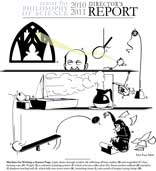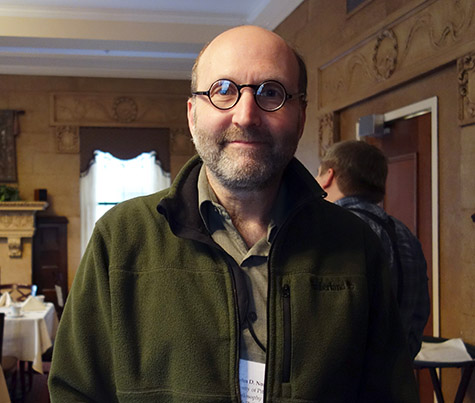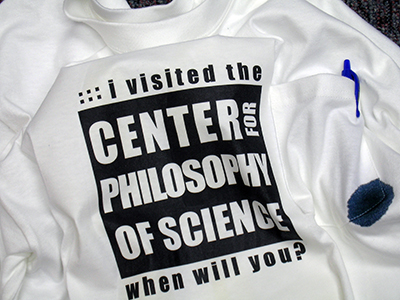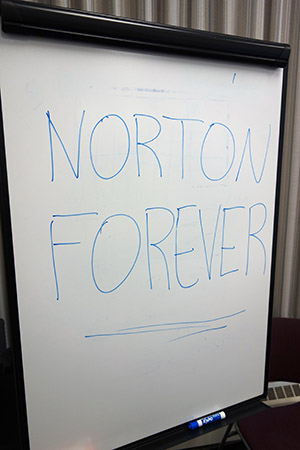

home
::: about
::: news
::: links
::: giving
::: contact
![]()
events
::: calendar
::: lunchtime
::: annual
lecture series
::: conferences
![]()
people
::: visiting fellows
::: postdoc fellows
::: senior fellows
::: resident fellows
::: associates
![]()
joining
::: visiting fellowships
::: postdoc fellowships
::: senior fellowships
::: resident fellowships
::: associateships
![]()
being here
::: visiting
::: the last donut
::: photo album
::: center home >> news >> 2015-16 annual review |
|
Director's 2015-16 Annual Review, Continued
This August 2016, as I sit here writing, is my last month as Director. I have carried the responsibilities of Director for over ten years. While the official appointment started in September 2005, the work began in earnest in January 2006. (John Earman kindly stood in as Acting Director for a term, so I could take a short leave.) It has been a rich and rewarding decade and I take this opportunity to reflect back on it. The Center for Philosophy of Science is thriving and has never been stronger. No one person can take credit for that. We are a collaborative community. Everyone contributes, including Directors, Fellows, local faculty and the Center's staff. In the more than half century of its life, the Center has had many Directors. Each has contributed in building one or other part of the Center and each can report proudly on his achievements. This now is the occasion for me to recall my contribution. The Center left to me in 2006 by departing Director Jim Lennox had many strengths. Most important, under Jim's tenure, the Center had finally found a firm fiscal foundation, so that budgetary constraints ceased to be the dominant worry. That was a major achievement. Jim also left me a Center rich in intangibles. It came with a powerful international reputation and a large community of dedicated past Fellows, all of whom had visited Pittsburgh and (mostly) benefited creatively from the experience. Finally, it had a capable and experienced staff. There were two problems that needed to be addressed immediately in 2006. First, our usually healthy applications for Visiting Fellowships had dropped precipitously. We had only two for the coming year. I spent many nervous hours seeing if I could find some more visitors. It was a difficult juggle. I wanted the invitation to sound like an honor, while not betraying my novice Director's desperation! This set off alarms. Had the community finally decided that we were just not worth the trouble of visiting? A little investigation revealed that we had the opposite problem. We were so revered that eminently qualified scholars felt they were not good enough to make the cut. We were living the curious paradox of a Center perceived to be so exclusive that no one could go there! This triggered a marketing campaign. It was designed quite explicitly to show that the Center is full of real humans with strengths and weaknesses, fears and ambitions, just like you! Some of you may remember the t-shirt flyer we produced.
It mimicked a vacation postcard and included a leaky pen, just to make sure that everyone knew that we knew that no one is perfect. Carol Weber and I actually made the t-shirt and photographed it. It had proved too hard to Photoshop something realistic. This was also the time that I started writing the "donuts pages." They are, ostensibly, a simple report of activities in the Center. Their real purpose was deeper. It took me a while to develop my voice in writing the pages. I came to love writing them. There is no shortage of records that Professor X gave a talk Y in venue Z. The record is so sparse that the talk could have been given by an automaton. I wanted to document the hidden side, the human experience of it all. For we academics, that is the real world. It is a world of late nights, of work and worry, of love and fear and hope and joy. The second of the immediate problems was that the Center was lagging behind in technology and the internet. We had many files and records of past visitors to keep and coordinate. As much as possible was loaded into a networked database. Was Professor X ever a visitor? The answer could now be found quickly in a simple search. We were still largely in the era of printed paper. During my first year, we carried out a complete rebuilding of the Center's website. We dropped paper mailings. The website became our primary means of publicity. Short emails, with just a few lines of text, are now sent out monthly, all with the goal of directing attention to the website. We began a policy of recording everything on the website. All talks, visits, events and so on. And it is done in a way that is automatically self-archiving. The Center history writes itself through the historical layers of the website. This Director's Review is a part of that policy. We take care each year to record as much as we can of what happened in the previous year. If this website is preserved, we will never again have to go back and try to reconstruct the history. It is all here. The website also has our photo album. I started to photograph every event and post the photos on the website. The small photos that you see when an album page first loads are low resolution. The high resolution image, however, is linked to the small photos and comes up with just a click. It is more than an album. It is collection of high resolution images of ten years of philosophy of science. For more see this. These were the immediate problems that had to be addressed. The more important questions were longer term. How is the Center faring? Are we doing what we should be doing? Are we doing things we should not be doing? What should the Center be like five years from now? These are hard questions to answer. So, with the help our assigned graduate student, Brian Hepburn, I started collecting data-- as much data as possible. The goal was to get a concrete quantitative picture of who comes to the Center, what we do here and anything else quantifiable about us; and compare it to what happens at other Centers and in the larger profession. All this was then presented for discussion and decision to the collected, if reluctant, Officers of the Center in a retreat, held over two days in February 2006. The most important outcome of that retreat was a rewriting of the Center's mission statement. It was reduced from a fulsome 149 word paragraph to the simple statement: "The Center for Philosophy of Science fosters the emergence of the best, new work in philosophy of science." This brevity is important. A mission statement is a decision tool. There are always many choices to be made. A long mission statement provides no guidance. No matter what idea pops up, there will be some clause in a bloated mission statement to authorize it. A short mission statement, however, will tell you what not to do; or what to give less priority. That mission statement became the foundation for all the planning that followed. Otherwise, the close examination of the Center proved encouraging. In almost all areas, we were doing well and the best advice was to keep doing what we were doing. There were several areas, however, where we fell behind the activities of other Centers. • While the Center would hold conferences, there was little proactive pursuit of a rich calendar of conferences and workshops. • The Center had no Postdoctoral Fellows and had even maintained a quiet policy of discouraging visits from very junior scholars. • The research areas of Fellows each year was governed simply by who applied. There was no focus in any one area. Over the course of the years that followed, all these shortcomings were rectified. The easiest concerned conferences and workshops. I started to recruit conferences and, very soon, we were holding four or more regularly each year. We established an internal protocol for the running of conferences. It involved detailed proposals from organizers to the Officers who then had the final say, via a vote, in which conferences would be supported. The promotion of junior scholars was a greater hurdle since they need substantial financial support. They are not established scholars visiting on sabbatical support. Provost Jim Maher came to the rescue. In response to pleas from me, he authorized two Postdoctoral Fellowships, starting in 2009. This was a great boost to us and, I was pleased to find, that Jim agreed to authorize a healthy stipend and to include medical benefits as an add-on. The final shortcoming was the lack of any research focus each year. We would not want a year to be devoted fully to just one area. We always want a mix of areas each year. But it would be good to have a small concentration of interests each year. There seemed, initially, no way to achieve this. When the applications for Fellows came in, we felt compelled to pick the best scholars; and that automatically decided the range of topics. What changed was support from the Wagner Foundation, starting in 2011, for research into risk. We brought in two Senior Fellows, sequentially, and ended up focussing 2011-12 on the topic of risk. This and a fortunate accumulation of funds provided a template that we followed in subsequent years. Each year we bring in a Senior Visiting Fellow whose scholarship is internationally recognized. The scholar's presence is advertised ahead each year, so that we can encourage Postdoctoral and Visiting Fellows with interests in similar areas. The result is that we now have a small concentration of Visitors each year, working in the same area, while other areas are still represented. The Senior Visiting Fellow also chairs a conference of their choosing, which usually brings the year to a fitting and exciting close. My overall sense is that the Center has benefited greatly from these changes. There was one final change that is harder to see from the outside, but was, I believe, transformative. The collegial culture in the Center has always been strong. It is the reason to come to the Center. You are immersed in an intellectually vibrant community of philosophers of science. I slowly set about reinforcing that culture. There were some simple ideas. I had to encourage the Fellows to come in each day and work in their offices. If everyone works from home, we have no community. Each needs to know that coming to the Center each day will likely lead to the momentary interactions that build into chance exchanges of ideas, friendships and collaborations. The most important step was the inauguration of weekly reading group meetings. They become the social and intellectual focus of Fellows. We would meet and discuss each others' work and then the Center would cover a modest dinner for everyone at some local restaurant. I did everything I could to make these meetings congenial and productive. In the first meeting, I would set the tone by lamenting the combative nature of philosophy of science. I would insist that these meetings must be different. They would be supportive and helpful. Each week, I would provide food and always make something of a fuss about it. To sit around a table sharing food is a universal signal that we are meeting as a family. My impression, based in part on the strength of many years of exit reports from the Fellows, is that these meetings proved one of the most valuable events for our Fellows. In building a sense of community, I took a small lesson from organized religion. There it was found that shared rituals have the power to bond people. So we started to build rituals into our routine. We give our speakers umbrellas as souvenirs of their talks. We chose them over coffee mugs and t-shirts because they are intrinsically funny. However the presentation of the umbrella at the end of a talk rapidly became a mock-serious moment for which the talk audience has learned to wait. To "get your umbrella" is a rite of passage for every Center Fellow. We added further rituals. For example, the instant photos of Fellows pinned to the board were started merely as a convenience in identifying our visitors. They soon became something more. The taking of the photos was ritualized and the resulting photos age into objects of veneration, something like the relics of the saints. They are eventually displayed in formal frames by year, somewhat like archeological specimens. To be photographed now has long-term significance. You create your tangible place in our philosophical pantheon. The world map at our front door has a pin locating the home of every Fellow. After we renovated the map, each pin is indexed and its owner identifiable. When new Fellows arrive, we all assemble in front of the map and each takes his or her turn in the ceremonial placing their pin. These and other shared experiences helped speed a disparate collection of visitors into a collaborative community. Now, over ten years after I stepped into the Director's office, I look back on my time with great satisfaction. As did all Directors before me, I have tried to leave a better and stronger Center than the one I found. I hand it over now to our new Director, Edouard Machery. It is time for a new Director. He will see the strengths of the Center and preserve them. He will also see the shortcomings that I do not see or that I no longer have the energy to address. A new and greater era will begin. John D. Norton
|


